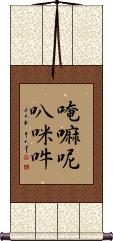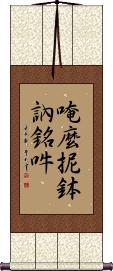Many custom options...
And formats...

Hum in Chinese / Japanese...
Buy a Hum calligraphy wall scroll here!
Personalize your custom “Hum” project by clicking the button next to your favorite “Hum” title below...
Om Mani Padme Hum
Om Mani Padme Hum
Oṃ maṇi padme hūṃ
唵麼抳鉢訥銘吽 is one of the earliest and best-known mantras in the Buddhist tradition.
It can be heard in temples from Tokyo to Tibet.
This mantra is an expression of the basic attitude of compassion. It translates literally as “oṃ the jewel in the lotus hūṃ.”
There are several titles and transliterations for this mantra, including, 六字大明呪 (Great 6-syllable mantra), 六字真言 (6-syllable Sanskrit mantra of Avalokiteshvara bodhisattva), 唵嘛呢叭咪吽, 唵嘛呢叭咪哞, and 唵嘛咪叭呢哞.
Contact me if you need any of these alternates on your wall scroll.
Not the results for Hum that you were looking for?
Below are some entries from our dictionary that may match your Hum search...
| Characters If shown, 2nd row is Simp. Chinese |
Pronunciation Romanization |
Simple Dictionary Definition |
妾 see styles |
qiè qie4 ch`ieh chieh shou / sho しょう |
More info & calligraphy: Mistress / Concubine / Servant(1) (See 妾・めかけ) mistress; kept woman; concubine; (pronoun) (2) (archaism) (humble language) (feminine speech) (See 妾・わらわ) I; me |
母 see styles |
mǔ mu3 mu haha(p); hawa(ok); kaka(ok); omo(ok); iroha(ok); amo(ok) はは(P); はわ(ok); かか(ok); おも(ok); いろは(ok); あも(ok) |
More info & calligraphy: Mother(humble language) (かか was used by children) (See 父) mother mātṛ, a mother. |
維 维 see styles |
wéi wei2 wei yuki ゆき |
More info & calligraphy: Vee(pronoun) (1) (kana only) this (indicating an item near the speaker, the action of the speaker, or the current topic); (2) (humble language) this person (usu. indicating someone in one's in-group); (3) now; (4) (archaism) here; (5) (archaism) I (me); (6) (archaism) certainly; (female given name) Yuki A carriage-curtain; a net; a corner, cardinal point; to tie or hold together, connect; a copula, also, but, whereas, now. |
愚女 see styles |
gujo ぐじょ |
More info & calligraphy: Daughter |
唵嘛呢叭咪吽 see styles |
ǎn má ní bā mī hōng an3 ma2 ni2 ba1 mi1 hong1 an ma ni pa mi hung |
More info & calligraphy: Om Mani Padme Hum |
唵麼抳鉢訥銘吽 唵么抳钵讷铭吽 see styles |
ǎn mó nǐ bō ne míng hǒu an3 mo2 ni3 bo1 ne4 ming2 hou3 an mo ni po ne ming hou on mani padomei un |
More info & calligraphy: Om Mani Padme Hum |
之 see styles |
zhī zhi1 chih yuki ゆき |
(possessive particle, literary equivalent of 的[de5]); him; her; it (particle) (archaism) possessive particle; (pronoun) (1) (kana only) this (indicating an item near the speaker, the action of the speaker, or the current topic); (2) (humble language) this person (usu. indicating someone in one's in-group); (3) now; (4) (archaism) here; (5) (archaism) I (me); (6) (archaism) certainly; (female given name) Yuki of |
伜 see styles |
cuì cui4 ts`ui tsui segare せがれ |
variant of 倅[cui4] (1) (humble language) son; (2) punk; brat; (3) (colloquialism) penis |
倅 see styles |
cuì cui4 ts`ui tsui segare せがれ |
auxiliary; spare; deputy; second; sub- (1) (humble language) son; (2) punk; brat; (3) (colloquialism) penis |
僕 仆 see styles |
pú pu2 p`u pu yatsugare やつがれ |
servant (pronoun) (archaism) (humble language) I; me; (personal name) Houyou A servant. |
共 see styles |
gòng gong4 kung domo ども |
common; general; to share; together; total; altogether; abbr. for 共產黨|共产党[Gong4 chan3 dang3], Communist party (suffix) (1) (humble language) (kana only) first-person plural (or singular); (suffix) (2) (derogatory term) (kana only) second or third person plural (implies speaker is of higher status than those referred to); (given name) Tomoni All altogether, both, same, in common. |
吟 see styles |
yín yin2 yin gin ぎん |
to chant; to recite; to moan; to groan; cry (of certain animals and insects); song (ancient poem) (1) recitation (of a poem); chanting; singing; (2) composition (of a poem); composed poem; (n,n-suf) (3) classical Chinese poetry form; (n,suf) (4) stress of sound in noh song; (female given name) Gin Chant, hum, mutter. |
吽 see styles |
hǒu hou3 hou un |
roar or howl of an animal; bellow of rage M020011 Translit. for hūṃ, which is interpreted as the bodhi, or omniscience, of all Buddhas. |
哼 see styles |
hēng heng1 heng |
to groan; to snort; to hum; to croon; humph! |
唵 see styles |
ǎn an3 an on おん |
(interjection) oh!; (dialect) to stuff something in one's mouth; (used in buddhist transliterations) om (interjection) (See オーム) om (ritual chant in Hinduism, etc.); aum oṃ; auṃ; 'a word of solemn affirmation and respectful assent (sometimes translated by yes, verily, so be it, and in this sense compared with Amen). 'M. W. It is 'the mystic name for the Hindu triad', and has other significations. It was adopted by Buddhists, especially by the Tantric school, as a mystic spell, and as an object of meditation. It forms the first syllable of certain mystical combinations, e. g. 唵?呢叭 061971 吽 oṃ maṇi padme huṃ, which is a formula of the Lamaistic branch, said to be a prayer to Padmapani; each of the six syllables having its own mystic power of salvation from the lower paths of transmigration, etc.; the formula is used in sorcery, auguries, etc.; other forms of it are 唵?呢鉢頭迷吽; 唵麽抳鉢訥銘吽. |
嗡 see styles |
wēng weng1 weng |
(onom.) buzz; hum; drone |
姐 see styles |
jiě jie3 chieh ane あね |
older sister (humble language) older sister; elder sister |
弊 see styles |
bì bi4 pi hei / he へい |
detriment; fraud; harm; defeat (1) (rare) bad habit; harm; (prefix) (2) (humble language) (See 弊社) my; our; (personal name) Minegawa Worn out, reduced to extremities, corrupt, deceptive; my, mine. |
御 see styles |
yù yu4 yü go ご |
(bound form) imperial; royal; (literary) to drive (a carriage); (literary) to manage; to govern (prefix) (1) (honorific or respectful language) (polite language) (humble language) (kana only) (usu. before a term with an on-yomi reading) (See 御・お) honorific-polite-humble prefix; (suffix) (2) (honorific or respectful language) (after a noun indicating a person) honorific suffix; (personal name) Mitomo to steer |
惟 see styles |
wéi wei2 wei yui ゆい |
-ism; only (pronoun) (1) (kana only) this (indicating an item near the speaker, the action of the speaker, or the current topic); (2) (humble language) this person (usu. indicating someone in one's in-group); (3) now; (4) (archaism) here; (5) (archaism) I (me); (6) (archaism) certainly; (female given name) Yui To reflect on; but, only; verbal particle; of. 唯. |
愚 see styles |
yú yu2 yü gu ぐ |
to be stupid; to cheat or deceive; me or I (modest) (noun or adjectival noun) (1) foolishness; silliness; stupidity; folly; (pronoun) (2) (archaism) (humble language) I; me; (given name) Gu Monkey-witted, silly, stupid, ignorant. |
拙 see styles |
zhuō zhuo1 cho setsu せつ |
awkward; clumsy; dull; inelegant; (polite) my; Taiwan pr. [zhuo2] (noun or adjectival noun) (1) (archaism) poor; unskillful; clumsy; (pronoun) (2) (humble language) (masculine speech) I; me; (personal name) Tsutana Stupid, clumsy. |
某 see styles |
mǒu mou3 mou bou / bo ぼう |
some; a certain; sb or something indefinite; such-and-such (n,pref) (1) certain; one; (pronoun) (2) (archaism) (humble language) (masculine speech) (See 某・それがし・2) I; me; (personal name) Norikazu certain..(person or thing) |
父 see styles |
fù fu4 fu chichi(p); chan(ok); tete(ok); kazo(ok); kaso(ok); shishi(ok); ate(ok) ちち(P); ちゃん(ok); てて(ok); かぞ(ok); かそ(ok); しし(ok); あて(ok) |
father (humble language) (See 母) father; (surname) Chichi pitṛ, 比多 Father. |
老 see styles |
lǎo lao3 lao rou / ro ろう |
prefix used before the surname of a person or a numeral indicating the order of birth of the children in a family or to indicate affection or familiarity; old (of people); venerable (person); experienced; of long standing; always; all the time; of the past; very; outdated; (of meat etc) tough (n,n-pref,n-suf) (1) old age; age; old people; the old; the aged; senior; elder; (pronoun) (2) (archaism) (humble language) (used by the elderly) I; me; my humble self; (surname) Rou jarā; old, old age. |
臣 see styles |
chén chen2 ch`en chen omi; shin おみ; しん |
state official or subject in dynastic China; I, your servant (used in addressing the sovereign); Kangxi radical 131 (1) (archaism) retainer; attendant; (2) (おみ only) (archaism) (See 八色の姓) Omi (hereditary title; orig. one of the two highest such titles, later demoted to sixth highest of eight); (pronoun) (3) (しん only) (humble language) (used by a servant when speaking to their master) I; me; (surname) Tomi minister |
誐 see styles |
é e2 o ga |
To intone, hum; translit. ga. |
賤 贱 see styles |
jiàn jian4 chien shizu; sen しず; せん |
inexpensive; lowly; despicable; (bound form) (humble) my (1) (archaism) lowly person; lowliness; (pronoun) (2) (しず only) (archaism) (humble language) (used by male entertainers) I humble |
うむ see styles |
umu うむ |
(interjection) (1) yes; yeah; uh huh; (2) hum; hmmm; well; erm; (place-name) Umu |
うん see styles |
un ウン |
(prefix noun) some (at the start of a number in place of a digit); (interjection) (1) yes; yeah; uh huh; (2) hum; hmmm; well; erm; (3) moan; groan; grunt (of pain); (female given name) Un |
Click here for more Hum results from our dictionary
The following table may be helpful for those studying Chinese or Japanese...
| Title | Characters | Romaji (Romanized Japanese) | Various forms of Romanized Chinese | |
| Om Mani Padme Hum | 唵嘛呢叭咪吽 | ǎn ma ní bā mī hōng an3 ma5 ni2 ba1 mi1 hong1 an ma ni ba mi hong anmanibamihong | an ma ni pa mi hung anmanipamihung |
|
| Om Mani Padme Hum | 唵麼抳鉢訥銘吽 唵么抳钵讷铭吽 | on mani padomei un onmanipadomeiun | ǎn mó nǐ bō míng hǒu an3 mo2 ni3 bo1 ne4 ming2 hou3 an mo ni bo ne ming hou anmoniboneminghou | an mo ni po ne ming hou anmoniponeminghou |
| In some entries above you will see that characters have different versions above and below a line. In these cases, the characters above the line are Traditional Chinese, while the ones below are Simplified Chinese. | ||||
Successful Chinese Character and Japanese Kanji calligraphy searches within the last few hours...





